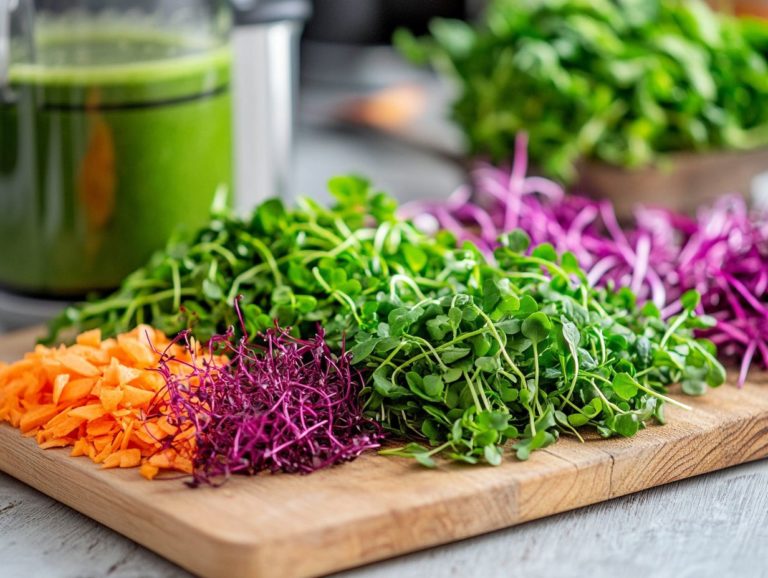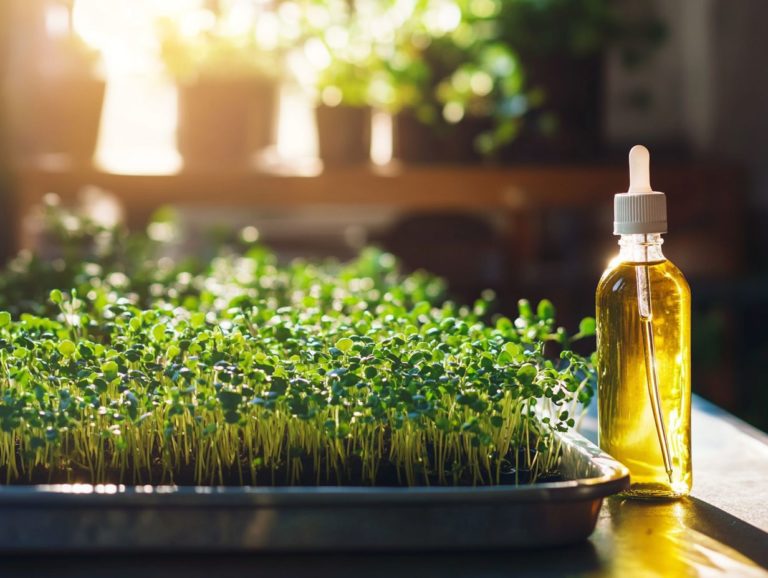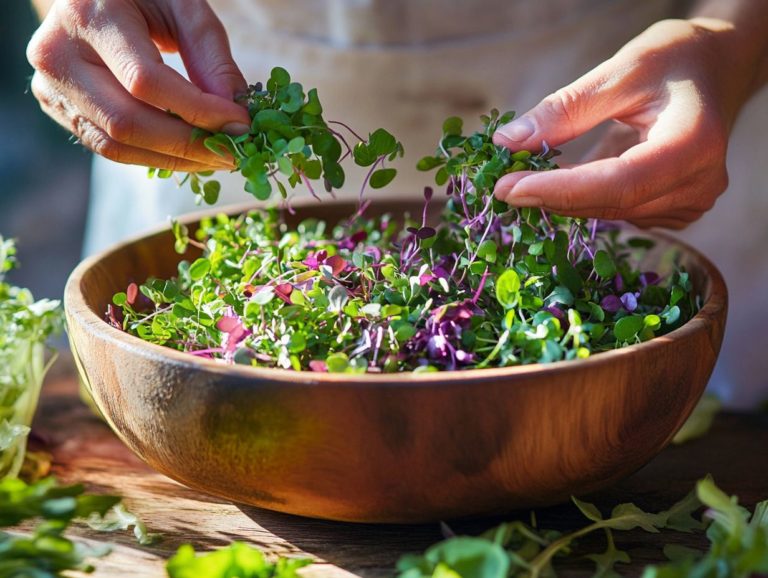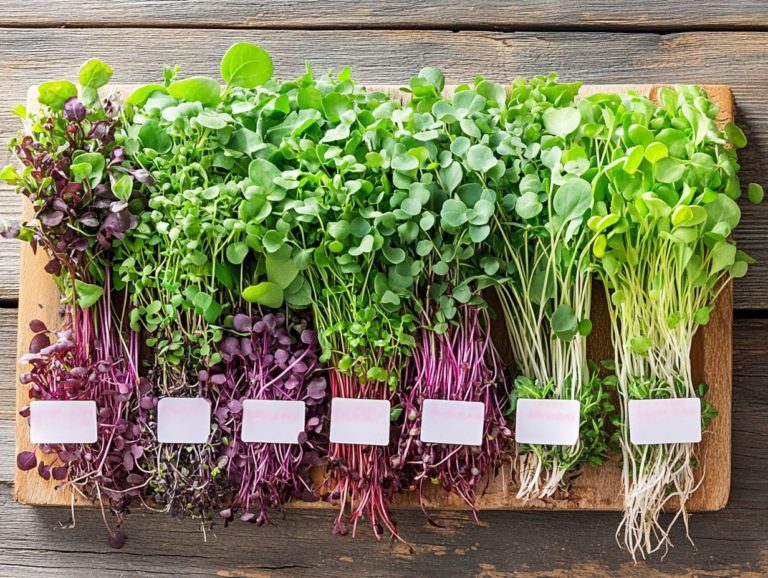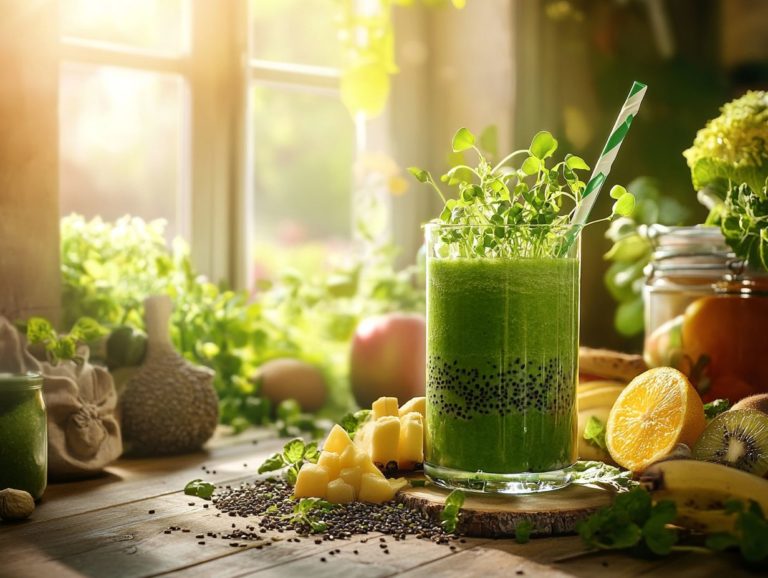How to Avoid Overwatering Microgreens?
Microgreens have become a sought-after delight for both home gardeners and chefs, celebrated for their vibrant flavors and impressive nutritional benefits. This guide will help you understand how to avoid overwatering and keep your microgreens thriving!
One of the key challenges in growing these petite greens is getting the watering right and understanding the optimal conditions for growth. Overwatering can spell disaster, leading to issues like mold growth and root rot, putting your hard work at risk.
Prepare to nurture your greens with the confidence of a seasoned gardener, utilizing effective plant care techniques and proper watering methods!
Contents
- Key Takeaways:
- What are Microgreens?
- Signs of Overwatering Microgreens
- Causes of Overwatering
- Preventing Overwatering
- Best Practices for Growing Microgreens
- Frequently Asked Questions
- What is overwatering and why is it harmful for microgreens?
- How can I tell if I am overwatering my microgreens?
- What is the ideal amount of water to give microgreens?
- How often should I water my microgreens?
- Are there any methods to help avoid overwatering microgreens?
- What should I do if I have already overwatered my microgreens?
Key Takeaways:
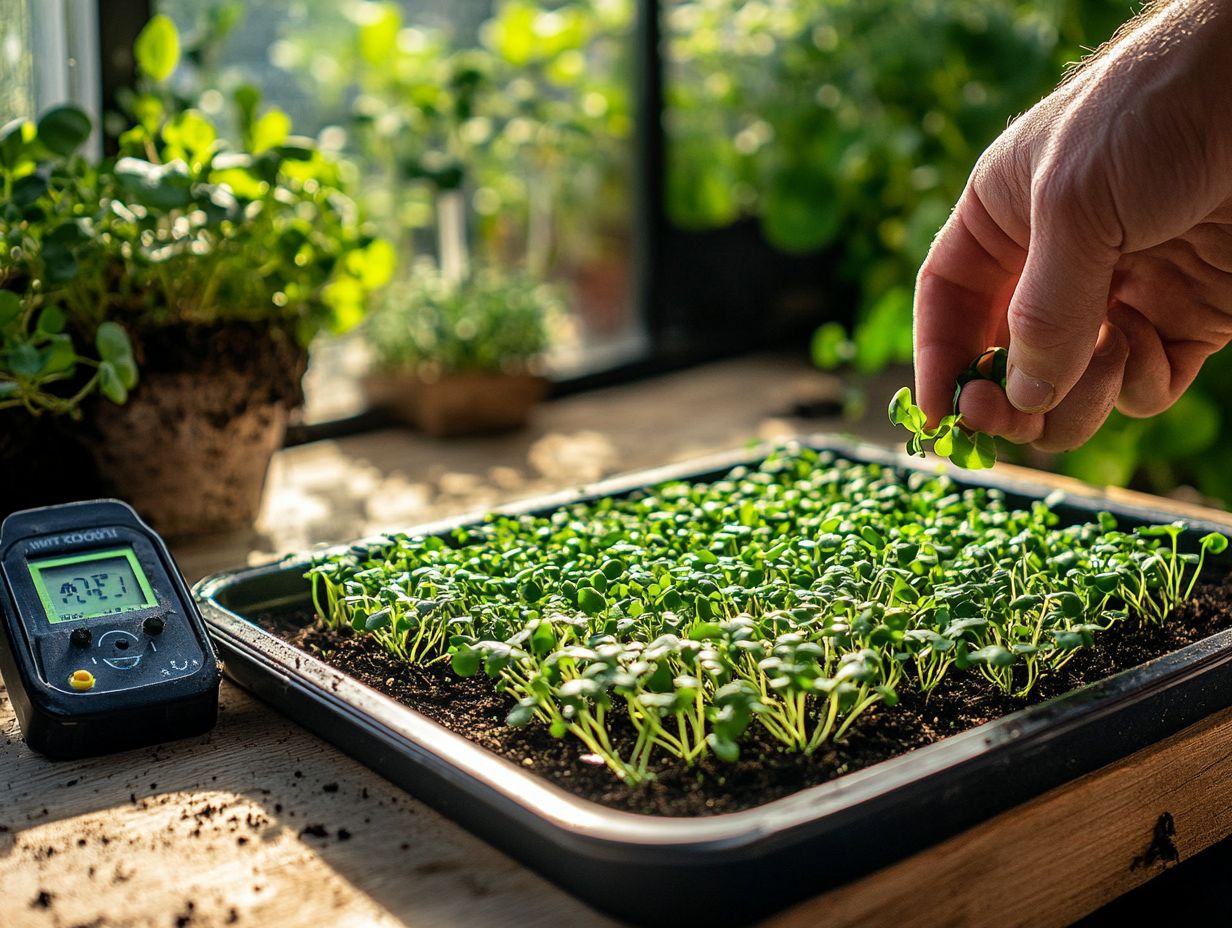
- Monitor for signs like yellowing leaves and mold growth to prevent damage to your microgreens and ensure optimal moisture balance.
- Avoid common mistakes such as over-irrigation and poor drainage that can lead to overwatering, increasing tray weight and moisture retention.
- Follow proper watering techniques and maintain optimal growing conditions, such as light levels and humidity, to prevent overwatering and ensure healthy growth of microgreens.
What are Microgreens?
Microgreens are young, edible plants that you can harvest right after their first true leaves emerge typically within 7 to 21 days post-germination, making them a quick and rewarding choice for seed starting. These little powerhouses are bursting with flavor, nutrients, and stunning colors, which is why they ve become a favorite among chefs and health enthusiasts alike, leading to a rise in microgreens podcasts discussing their benefits.
Varieties such as celery, basil, mustard, cilantro, chervil, and edible chrysanthemum are often cultivated in home microgreens setups. This offers you an effortless way to grow nutrient-rich greens right in your kitchen or garden space.
Signs of Overwatering Microgreens
Recognizing the signs of overwatering your microgreens is essential for fostering robust plant growth and ensuring proper water absorption. Excess moisture invites a host of problems, including root rot a condition where plant roots decay due to excess water nutrient deficiencies, and other related issues.
Watch for these key indicators that signify overwatering:
- Waterlogged soil that affects moisture retention.
- Unexpected increase in tray weight, indicating excess water volume.
- The appearance of mold on the soil surface due to high humidity levels.
Act quickly if you notice these signs to save your microgreens! These issues can impede seed germination and stifle your microgreens’ overall growth. Understanding how to choose the best hydration methods for microgreens can help prevent these problems.
Identifying Overwatering in Microgreens
Identifying overwatering in your microgreens requires a keen eye for specific signs related to water absorption and moisture levels. Look for a consistently wet soil surface, an increased tray weight, and stunted growth all signs that excessive moisture is suffocating the plant roots.
You might notice the leaves starting to yellow or wilt, indicating that the plants are in distress due to submerged roots that can t access the oxygen they need, affecting their growth.
To assess moisture levels in the soil effectively, consider investing in a moisture meter. For many growers, a simple finger test can do the trick to gauge appropriate watering frequency. Just stick your finger about an inch into the soil; if it feels damp, you re in good shape. If it s dry, it s time to water using your preferred method!
Learn how much water each variety needs to thrive—your microgreens will thank you! Understanding the right amount of water tailored to each microgreen variety is essential, as different species have unique moisture requirements that can significantly affect their growth, flavor profiles, and overall health.
Causes of Overwatering
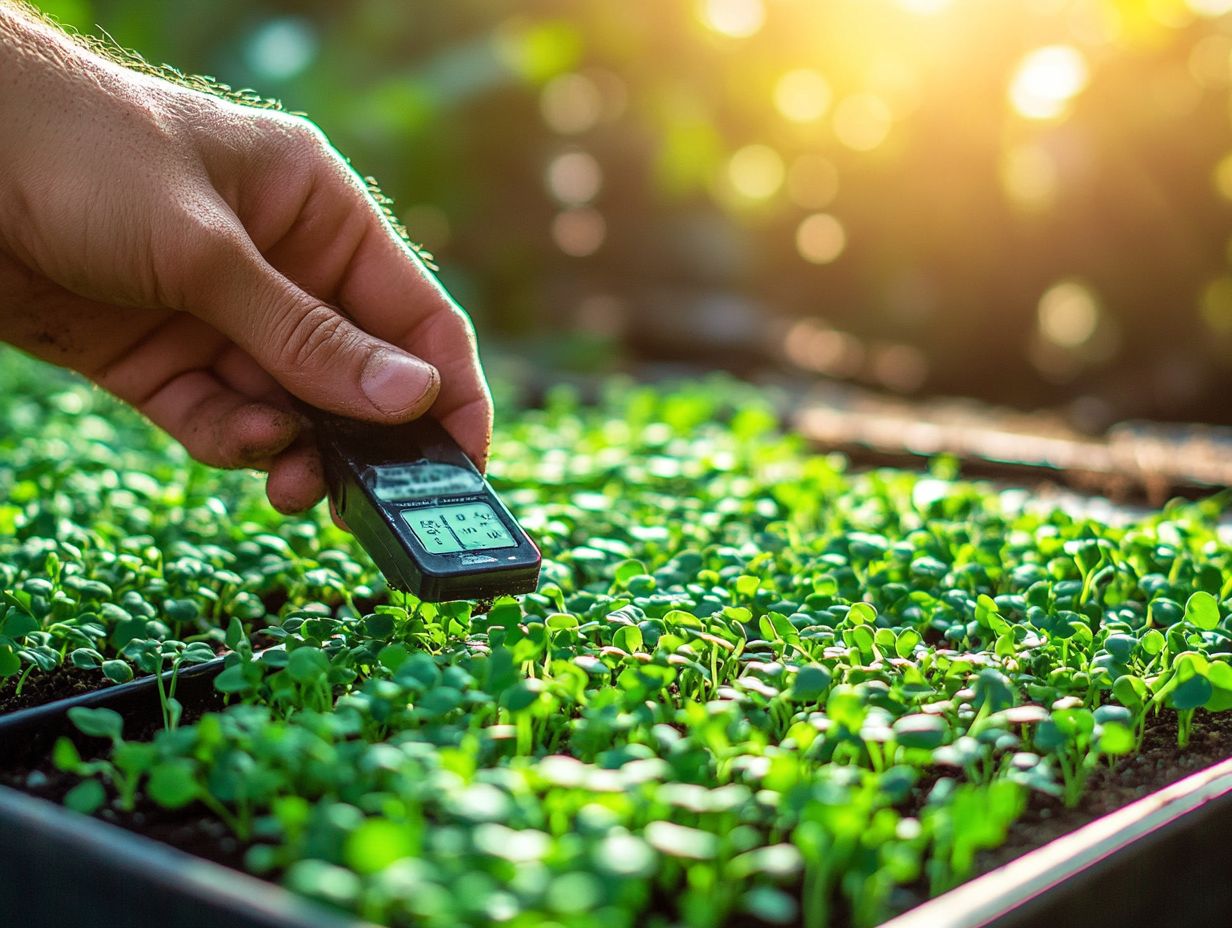
Overwatering microgreens often arises from not watering enough and improper soil type. Environmental factors like humidity levels and air movement can also hinder growth.
These issues can lead to excessive water retention, making it difficult for the plants to absorb essential nutrients. This can result in stunted growth or even the demise of the plants due to poor watering strategies.
Common Mistakes and Factors
Common mistakes that lead to overwatering microgreens often stem from using the wrong watering methods. Failing to adjust the watering schedule according to humidity levels can also contribute to this issue.
Many growers overlook the important role that soil type plays in moisture retention and water absorption. Heavy soils can retain too much water, increasing the risk of root rot, while lighter soils may dry out too quickly.
It s essential to align your watering method whether you choose bottom watering or bulk watering with the specific needs of the microgreens you re cultivating.
A customized watering schedule that adapts to environmental changes like temperature and indoor humidity can profoundly enhance plant health. With this smart approach, your microgreens will flourish like never before!
Preventing Overwatering
Preventing overwatering requires effective watering techniques and best practices for moisture balance. Consider methods like bottom watering and bulk watering, while keeping an eye on your watering frequency.
Also, consider the soil composition and choose suitable watering adjustments based on the specific environmental conditions you encounter. This thoughtful approach will help ensure your microgreens thrive, leading to healthier plants and a successful harvest.
Proper Watering Techniques and Tips
Implementing proper watering techniques is crucial for the health and growth of your microgreens. This includes understanding water types and parameters.
Methods like misting seeds to maintain moisture balance and adjusting your watering frequency based on the specific variety of microgreens are vital. For detailed guidance, refer to how to water microgreens effectively. Techniques such as sprayer usage help ensure even moisture distribution.
By utilizing methods like capillary watering or bottom watering, you can provide a consistent supply of moisture without oversaturating the soil. Misting seeds not only helps maintain humidity levels but also encourages quicker germination. Additionally, knowing how to prevent spoilage in microgreens can further enhance your growing success.
It’s important that you monitor moisture levels regularly. Different microgreen varieties may require varying amounts of water. For example, radish microgreens thrive with more frequent watering, while basil can handle slightly drier conditions.
By fine-tuning these practices, you can cultivate a lush microgreen garden that flourishes and maximizes your harvest time.
Best Practices for Growing Microgreens
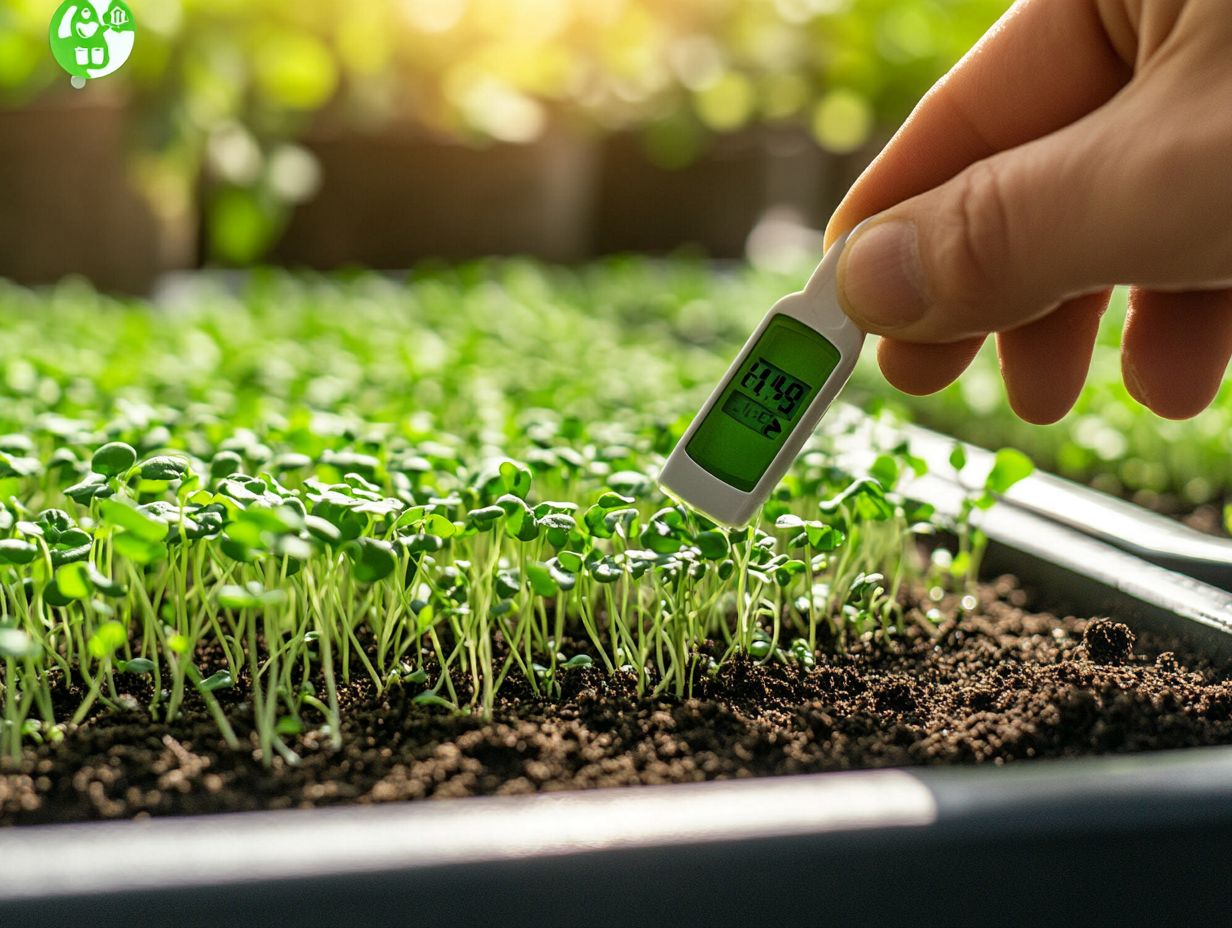
To successfully cultivate microgreens, it s essential to adhere to best practices in watering methods and soil composition. This includes:
- Establishing a consistent watering schedule
- Creating optimal conditions regarding light and humidity
- Employing effective plant care techniques tailored to each microgreen variety
These practices ensure the health and growth of your microgreens.
Tips for Maintaining Optimal Growing Conditions
To maintain optimal growing conditions for your microgreens, pay close attention to factors like light, humidity, and air movement. These factors directly influence nutrient availability and overall plant health.
Balancing these elements is crucial, along with proper watering techniques. Get ready to cultivate microgreens that are vibrant and nutrient-rich! For lighting, aim for a consistent 12 to 16 hours of bright, indirect light each day; this supports the process that helps plants grow while preventing heat stress, which can impact plant welfare. Additionally, learning how to keep microgreens fresh longer is vital for maintaining their quality.
Keeping humidity levels between 40% to 60% is equally important, as it helps prevent mold growth while providing sufficient moisture for seed germination and enhancing the effectiveness of watering methods.
Proper air circulation is essential; it not only diffuses heat but also promotes strong stem development, giving your microgreens a strong base for growth.
In essence, these practical tips serve as your blueprint for successful microgreen cultivation and maintaining a healthy watering strategy.
Check out our Microgreens Podcast for more information on growing microgreens!
Frequently Asked Questions
What is overwatering and why is it harmful for microgreens?
Overwatering refers to giving plants too much water, resulting in waterlogged soil and leading to issues like root rot and poor plant health. This can hinder the growth of microgreens, negatively impacting their flavor profiles and nutrient availability.
How can I tell if I am overwatering my microgreens?
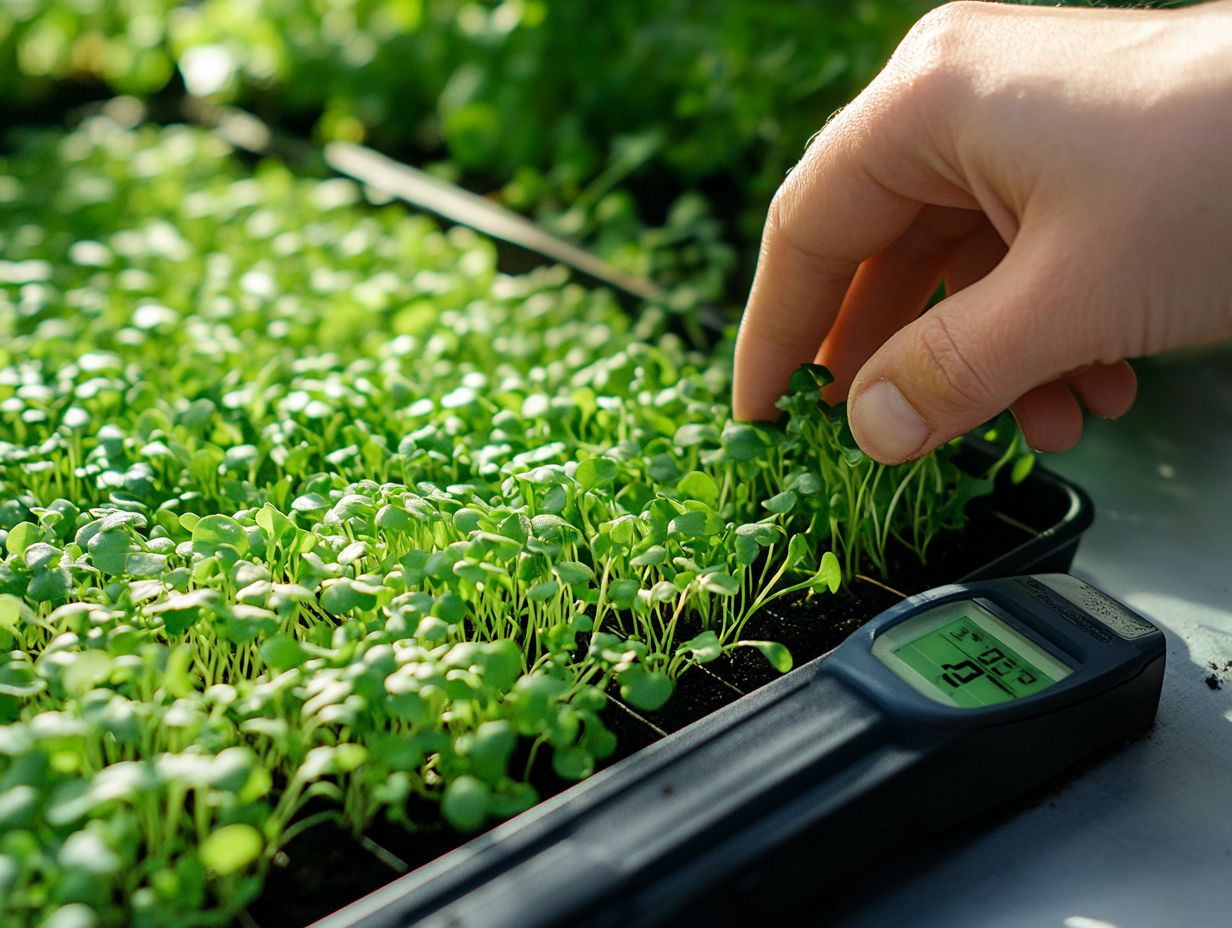
Signs of overwatering include yellowing or droopy leaves, slow growth, and a musty odor in the soil. You may also notice excessive moisture on the soil surface and fungus or mold growth, indicating poor environmental conditions and excess watering.
What is the ideal amount of water to give microgreens?
The amount of water needed for microgreens varies based on temperature, humidity levels, and specific microgreen varieties. As a general rule, the top inch of soil should be kept moist, but not waterlogged, to prevent detrimental overwatering problems.
How often should I water my microgreens?
This depends on the type of microgreen and its growing conditions, influencing the watering frequency and techniques. In general, microgreens should be watered once a day, but some may require watering every other day based on their species and water absorption needs.
Are there any methods to help avoid overwatering microgreens?
Yes, there are a few methods to help prevent overwatering, including proper watering techniques and understanding soil composition. These include using well-draining soil, implementing bottom watering strategies, and allowing the soil to dry slightly between waterings to ensure good moisture balance.
What should I do if I have already overwatered my microgreens?
If you have overwatered your microgreens, stop watering immediately and allow the soil to dry out while assessing the soil surface for excess moisture. You may also need to gently remove any excess water from the soil surface or adjust your watering schedule accordingly. If the plants show signs of damage, consider replanting with new seeds and adjusting your care tips for future success.

